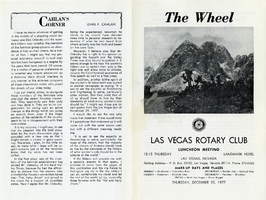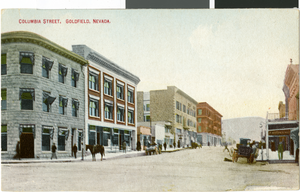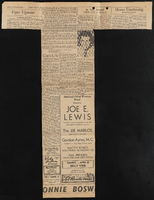Search the Special Collections and Archives Portal
Search Results
Robert Woodruff Papers
Identifier
Abstract
The Robert Woodruff Papers (1927-2001) are comprised of materials documenting Woodruff’s career and family life in Las Vegas and Henderson, Nevada, as well as his travels around the United States and abroad. Materials include newspaper clippings, photographic prints and transparencies, personal correspondence, and publications such as Las Vegas tourist brochures and pamphlets dating from the 1930s and 1940s. Visual materials include portraits, city scenes, and landscapes throughout Nevada and the United States, as well as some photographs of international travels.
Archival Collection

Stock certificate from the Nevada Keystone Mining Company, June 20, 1903
Date
Archival Collection
Description
Image

Transcript of interview with Mary Ellen Osborn Lake by Fred Wilson, February 18, 1951
Date
Archival Collection
Description
On February 18, 1951, Fred Wilson interviewed Mary Ellen Osborn Lake (born 1870 in Mercer County, Missouri) and her son, Thomas Lake (born 1889 in Missouri). Wilson first asked Mary Ellen questions about when she first arrived in Las Vegas, Nevada in 1904. Much of the relatively brief interview involved questions related to the first Methodist churches in Las Vegas and the Lakes’ involvement and recollections of the locations and members of the church community.
Text

The Wheel Las Vegas Rotary Club newsletter, December 22, 1976
Date
Archival Collection
Description
Text
McWilliams, J. T. (John Thomas), 1863-1941
Nevada pioneer, engineer, and surveyor John Thomas (J.T.) McWilliams was born in Owen Sound, Ontario, Canada, on December 10, 1863. In 1879, he moved to Detroit, Michigan, before settling in Chicago, Illinois in 1883. While in Chicago, McWilliams studied civil engineering at the University of Chicago, and in 1884 he began surveying for the Northern Pacific Railroad.
Person

Transcript of interview with Fred Gibson by Maisie Gibson, March 9, 1975
Date
Archival Collection
Description
On March 9, 1975, Maisie Gibson interviewed Fred Gibson (born 1927 in Golden, Colorado) about his life in Nevada. Gibson first talks about his family’s background, their move to Nevada, and his education in early Las Vegas schools. He also mentions his service in the U.S. Army, his college education, and his occupation as an engineer at various companies. Gibson then talks about the various locations at which he has lived, his membership in clubs and charitable organizations, and his memories of the first properties on Fremont Street as well as those of the Helldorado Parade. The interview then covers the topics of mining, the atomic testing, economic and environmental changes, and social changes. The interview concludes with a discussion on the growth and development of Henderson, Nevada.
Text

Postcard of Columbia Street, Goldfield, Nevada, circa early 1900s
Date
Archival Collection
Description
Image


